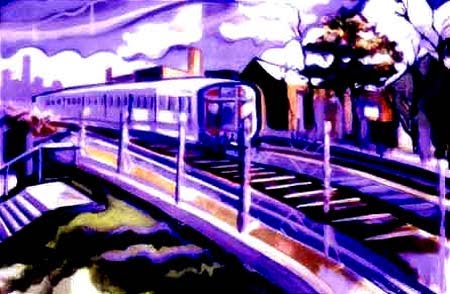Tuesday, February 26, 2013
Passenger Rail in New Hampshire
Since I was young, I've been traveling to New England to visit my uncle – and later his family – who lives in Nashua, N.H. My first train ride outside of Buffalo's Metro Rail light-rail line was on such a trip, as we headed down to Boston to tour the Freedom Trail and other historic places in downtown Boston. While we were there, we rode the MBTA's Blue Line subway. On a later vacation, my first commuter rail trip was on the MBTA's Lowell Line – the closest rail connection from Nashua to Boston. Later on, Amtrak's Lake Shore Limited took me and my aunt from the Buffalo-Depew station to Worchester on another visit and back home again – another first for me, marking my first intercity train experience. On other trips, we rode the Conway Scenic Railway and the Mount Washington Cog Railway in the state's north country region.
Suffice it to say, the passenger rail operations in New England were fundamental to my earliest interest in railroading. Each time I went, though, I asked my uncle and others why we couldn't just take the train right from Nashua to Boston? After all, I discovered fairly early on – via fold-up maps and gazetteers, the much more difficult precursor to today's internet mapping applications – that the same rail line that hosted the Lowell Line continued north, not only to Nashua but continuing on to the state's largest city of Manchester and it's capital, Concord. Indeed, just a few years before I began travelling to Nashua, the Boston & Maine Railroad still operated its Minute-Man trains on the route, offering multiple daily departures geared toward commuters and tourists (see timetable below).
After the Boston & Maine was acquired by Guilford Transportation in 1983, the service was curtailed from Concord to Lowell, as the MBTA acquired the route between there and Boston's North Station. From then until now, the line north of Lowell has only hosted Guilford – now known as Pan Am Railways – freight trains.
However, in recent weeks, significant momentum is emerging to restore passenger service on the route. On February 6, the New Hampshire Executive Council – which gives final executive approval to pressing state matters as a constitutional check on the governor's authority – voted to approve a $3.6 million feasibility study on resuming passenger rail operations.
While a study of a potential service hardly represents a firm decision to ultimately further the project, the Council's vote represents a significant shift in the state's attitude towards passenger rail. Just last year, the Council – then comprised of different members who either retired or were voted out of those positions in last November's elections – prevented the same feasibility study to move forward. Other passenger initiatives regarding the corridor – even an extension only as far as single station across the state line from Massachusetts in South Nashua – have never received committed state funding.
Just eight days later, the Nashua city board of aldermen approved a $1.4 million property purchase on Crown Street (see map below) where a new passenger rail station would be located. The local funds will be matched with $6.5 million in federal investment through the Congestion Management & Air Quality (CMAQ) program as well as $280,000 in highway toll credits through the state's Department of Transportation.
View Larger Map
The twin decisions demonstrate a new found interest and commitment by state and local leaders in New Hampshire to at least explore the possibility of passenger rail options in New Hampshire's most heavily-populated and economically important corridor.
Of course, the study's findings may yet convince those same leaders that the requisite levels of investment necessary to support service don't match the state's priorities, a reality Pan Am Railways President David Fink articulated quite reasonably in a recent editorial. An agreement with Pan Am would be paramount to the project, along with important decisions on station locations, service frequency, equipment and a service operator. None of these aspects will be arrived at quickly or inexpensively. Moreover, the state's longstanding resistance to developing passenger rail between Concord, Nashua and Lowell begs some substantial hesitancy.
Nonetheless, by agreeing to undertake a feasibility study and acquiring a potential station location, a foothold has been established for intercity and passenger rail through New Hampshire's Merrimack Valley for the first time in more than 30 years.
Tuesday, February 19, 2013
Guest Post: Trainsforming America
We're please to offer the first guest post at the Potomac Express, authored by Rebecca A. Sansom, the co-producer of a new documentary on the promise and potential of high-speed and intercity rail in the United States called Trainsforming America (Twitter: @trainsformingus) We asked Rebecca to share some of the broad themes of the film, which outline the import of renewed investment in passenger rail – not only in sweeping policy implications but also in a very real personal context. Stay tuned here, our @RAILMag Twitter handle and future editions of RAIL Magazine for further coverage of Trainsforming America!
Eve is in her seventies and lives in Deal, England. Her
children live in London. She enjoys living near the train station because she
doesn't want to drive into the city anymore.
Ana is terrified
of flying, but has to travel from London to Madrid about 4 times a year. She
opts for the overnight train to ease her anxiety.
The Martins live
in Grants Pass, Oregon which is similar in size to Deal, England. They tend to
drive everywhere, but wish there were more transit options like there are in
Portland.
Giuliano Scarsi
wishes he felt safe walking in Nashville, TN when he comes to visit his wife's
family, but notes, “There are no sidewalks!”
Clearly there is
a cultural difference when it comes to transportation here versus abroad. The
aim of this film is not to demonize our car culture, but to continue the
conversation about our pressing infrastructure needs. Our population is growing
at a rate that is not going to make it very pleasant for every American to own
their own automobile. As Stanford Professor, Anne Ehrlich, notes in the film,
“Having a 120-lb. person driving a 4,000-lb vehicle to get the groceries doesn't make a lot of sense.”
America needs to
lead by example when it comes to climate change solutions. Investing in more
passenger rail and building the California High-Speed Rail network will show the rest
of the world that we care about our children and grandchildren's futures enough
to evolve.
We let our passenger railroads deteriorate, and now our
roads and bridges are falling apart, too. What should we do? Do American
passengers want more and more people to drive on our already-congested
highways? Or, do they want the option to ride?
We don't think
history will remember the Marco Rubio's of the current political system, who say
there is no point in doing anything unless everybody does something. History
will remember the leaders that tried to make America a healthier and easier
place to, simply, live. People like Bernie Sanders and Barbara Boxer, who tried
to pass the Global Warming Pollution Reduction Act of 2007.
In fact, it seems
that climate change deniers are fine preaching Big Oil's tired diatribe that
climate change is not a threat when other countries are actually doing
something. Are we really going to let China surpass us on energy solutions like they already have in high-speed rail technology?
Why can't we commit to a robust, noble message about climate
change? Why can't we take steps to advance by investing in passenger rail? I
mean, honestly, the worst that could happen is we'll have cleaner air and less
stressed-out commuters.
After making this
film, we believe that the current public support for more sustainable and
efficient transportation options will result in a successful attempt to pass
progressive legislation concerning rail.
To quote President
Obama in his 2013 State of the Union Address, we need to “act before it is too
late.” The Forward on Climate rally was successful in exposing the dangers of
the Keystone XL pipeline. Rallies like
that are necessary to turn our government's silence on climate change into
action, and we hope films like ours will continue to further that aim.
As far as where
you can see the film, at this point we're trying our luck at the film festival
circuit. It would be nice to have a distributor acquire the film, but to do
that we need help from other rail enthusiasts to get the word out and garner
support for its release. If you would like to purchase a license to screen the
film for educational purposes, please send us a message. Check the website for
upcoming screenings.
Together, we are Trainsforming America!
Subscribe to:
Comments (Atom)









